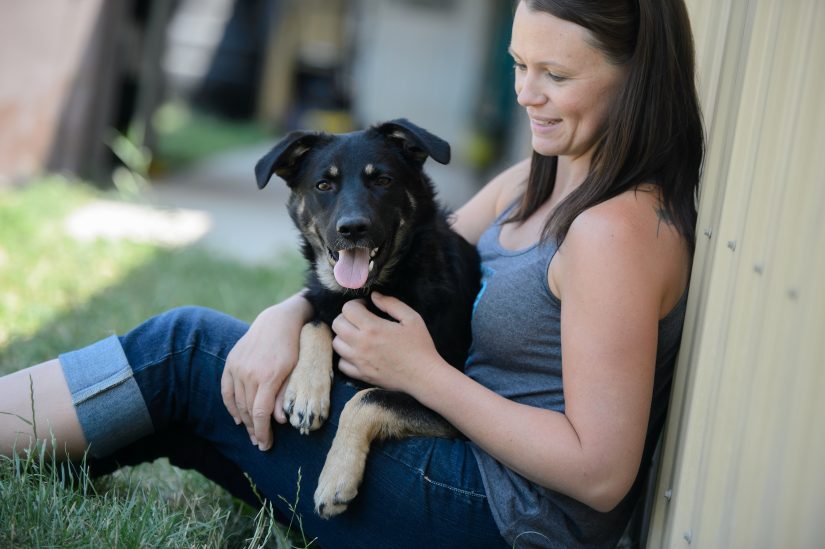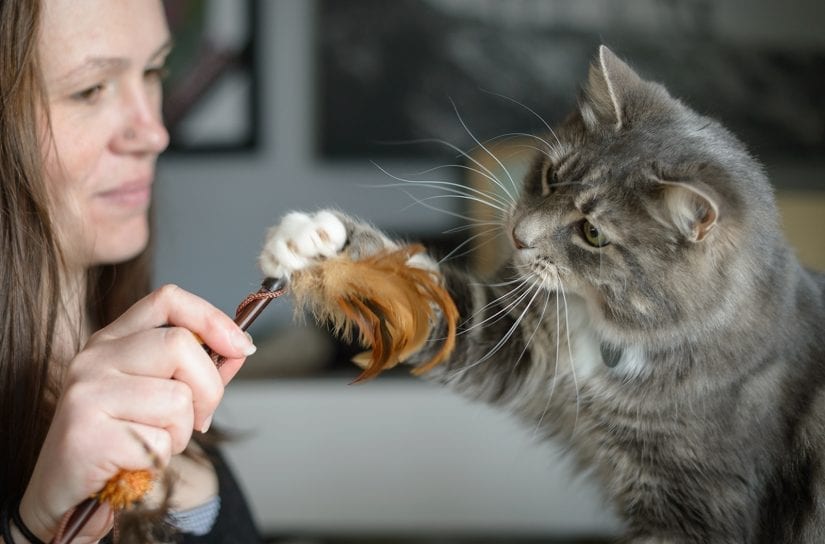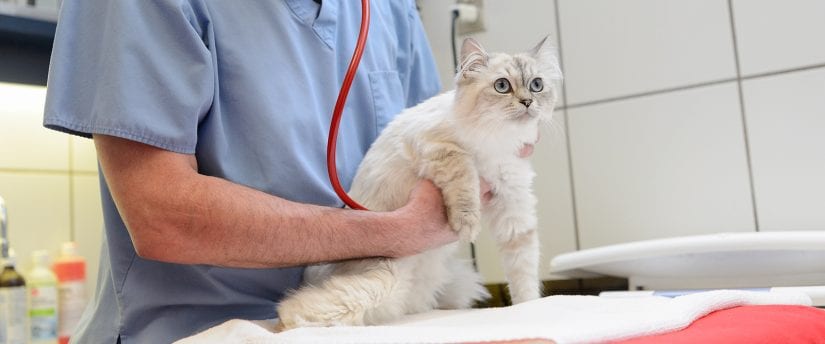Pet care & behaviour
Cats are wonderful companions. Each has a unique personality – just like people!
Some are shy and quiet while others are outgoing and social; but no matter the personality of your cat, they always rely on you as a guardian to provide a good home with what they need to be happy. Remember, a healthy cat is a happy cat!
Typical life span for a cat
- 13 – 20 years
How to keep your cat happy and healthy
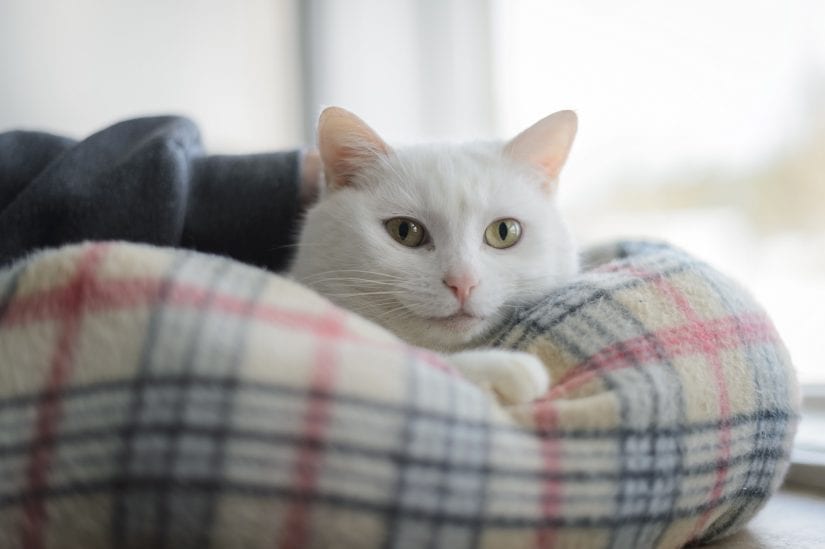
Cat food and feeding
Kittens need good quality kitten food when they’re weaned. Adult cats do best on a mixture of good quality dry kibble and canned food. Feeding guidelines provided on the bag can help you determine how much your kitten or cat should eat in a day.
It is common for most cats to eat two to three meals a day. Feed the last meal of the day right before bedtime. An adult cat will sleep throughout the night. Kittens may need more meals a day.
Some cats need special diets. Ask your vet for a recommendation for your cat.
Your cat must have access to fresh water all the time. Change the water daily and wash out the bowl regularly.

Cat grooming, teeth and nail trimming
Choose a pet service business that prioritizes your cat’s welfare. Learn what to ask so you can confidently choose the right pet care provider.
Grooming
Brush your cat on a regular basis, especially if they are long-haired. Regular brushing prevents hair from matting and removes loose hair. It also will help with hairballs.
Teeth
To keep your cat’s teeth healthy and tartar free, they need to be brushed daily. Buy a special toothpaste and finger brush from your local pet supply store or at your vet clinic. Do not use human toothpaste.
Nails
Nails need regular trimming, usually once a month or as needed. Take care not to cut the blood vessel (the quick) that runs through each nail. Cats who go outside do not need their nails trimmed. They need their nails to climb and defend themselves. If you prefer not to cut your own cat’s nails, a veterinarian can do this for you for a small fee.
Declawing cats
The practice of declawing cats is banned in B.C., unless it is necessary as an appropriate medical therapy. It is also banned in Australia, New Zealand, Israel, Brazil, the United Kingdom, parts of Europe and some cities in California.
Cats’ nails are not like fingernails — they’re attached to the bone. Declawing is a serious surgery. It’s like removing a part of your finger at the knuckle.
Read the BC SPCA Position Statement on Cosmetic and Other Non-Therapeutic Alterations (PDF).
*If your cat is scratching furniture, learn what to do.
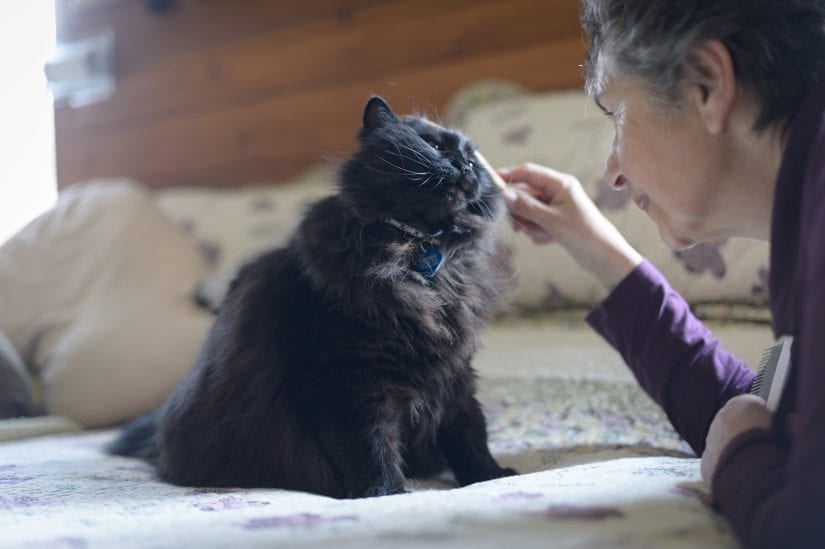
Identification (ID) for your cat
Nobody plans to lose a pet. Prepare for the unexpected and ensure your cat has two forms of identification.
Indoor cats vs outdoor cats
The BC SPCA recommends that cats be indoors, however, some cats get frustrated indoors and may enjoy outdoor time. Whether you choose to let your cat out or keep them in, know how to provide them with the best environment to keep them happy and safe.

Medical care is important for your cat
Take your cat to see a vet when you first get your cat. After the initial visit with the vet, you may only need to go back once a year for a check-up and vaccinations. Kittens will need to go back more often at first for vaccines.
It is also important to have your pet spayed or neutered to prevent unwanted litters. There are also many behavioural and health benefits to sterilization. Learn more about the benefits of spaying or neutering your pet.
Over time, watch for lumps and bumps on your pet. Also pay attention to signs of your cat not eating or a change in their behaviour. If you notice anything different talk to your vet.
Find a veterinarian in your area.
Learn how to make your kitten or cat’s vet visit less stressful.
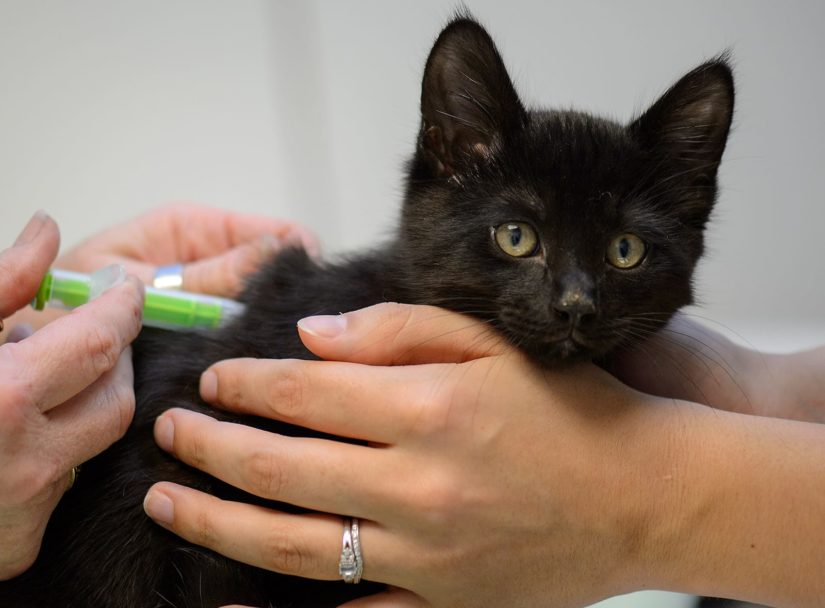
Playtime is a special time with your cat
Cats love to play, explore, run around, use a scratching post and spend time with you. These are all essential activities for cats. Set up your home so your cat can explore, run and scratch on a scratching post.
Make time in your day to play with your cat with a variety of toys, rather than your hands. Learn what to do if your cat or kitten is biting and scratching your hands.
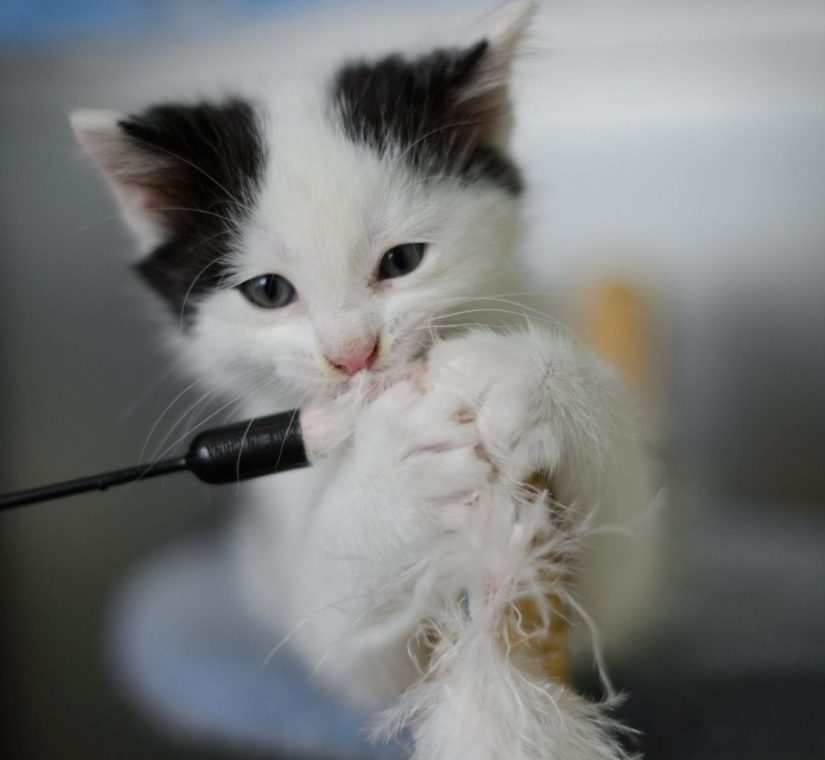
Further resources for cat care and behaviour issues:
Welcoming a new cat into your home
Introducing your new cat to your resident cat
Yes, with a new pet it’s always a good idea to take them to a veterinarian to make sure your new friend is healthy. You can also get all your questions answered about vaccines or health concerns. Call your vet to ask when to schedule your first visit.
Make sure you bring your pet’s favourite treats and don’t feed a big meal before going to the vet so your pet is excited to get treats. You want your puppy or kitten to love the vet and not be scared, and the best way to do this is to make it a great experience every time!
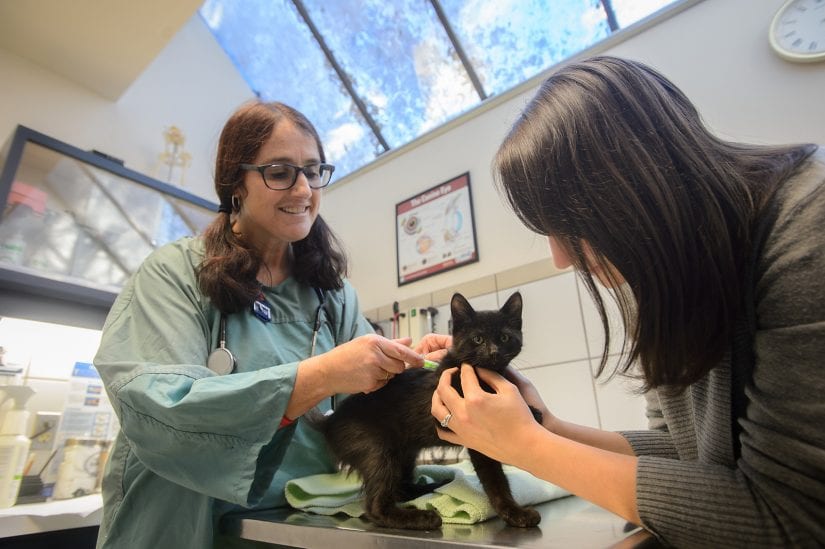
Be sure to ask about:
- Vaccines
- Deworming and parasite prevention
- Basic care – feeding, training, exercise
- Spaying/neutering
- Permanent ID such as microchip
- Future health needs and monitoring
Yes! In fact, Petsecure Pet Health Insurance provides a complimentary six-week trial of pet health insurance with every dog and cat adoption.
With pet health insurance, you can lower the stress of paying for large, unexpected or unplanned expenses with a monthly premium.

If you have cats in your community who appear to be living on their own outdoors, there are a few things you can do to help, especially during the winter months.
Get the cat spayed or neutered: The best method of getting feral cat populations under control is through trap-neuter-return (TNR). This involves trapping the cats, getting them spayed or neutered and vaccinated, and then returning them back to their environment. In addition to humanely reducing the population, TNR also improves the health of the cats and makes them better neighbours.
Contact your local SPCA or cat rescue for advice on how to humanely and safely trap a feral cat. They may even have a trap loan or TNR program to assist you. Community programs are available to help spay and neuter cats to help fight the cat overpopulation problem in B.C.
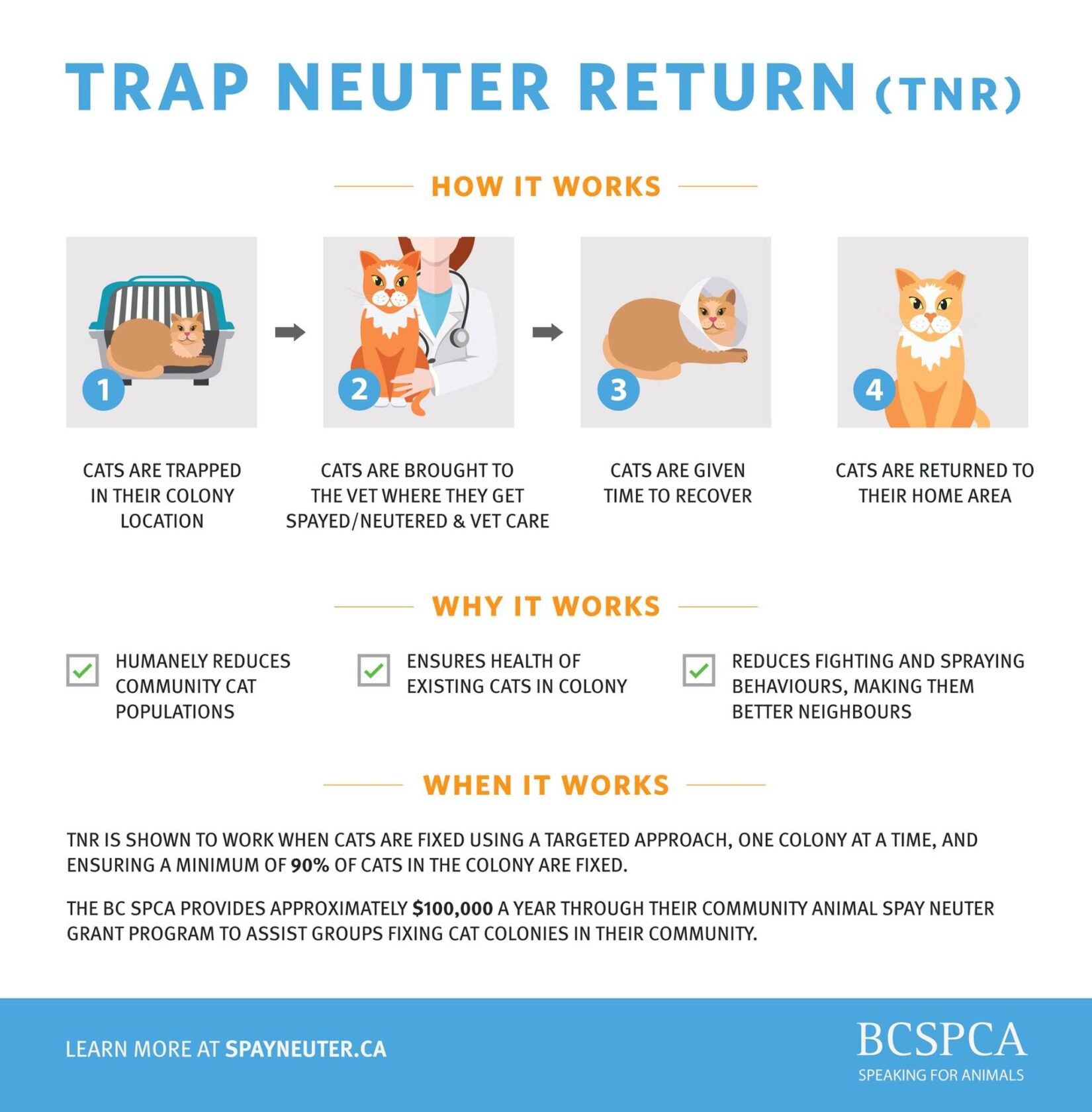
Ensure access to food and water: Food should be left out for cats only during feeding time and then removed to ensure it doesn’t attract wildlife such as raccoons, skunks or bears.
Water should be available at all times. In winter, water sources and wet food can easily freeze over. When you put out water for cats, check it twice daily to make sure it stays ice-free. During the winter, choose dry kibble and ceramic or plastic dishes.
Check your local bylaws: There may be provisions in your municipal bylaw that require you to register the cat colony, or ensure that all cats have permanent identification such as a tattoo or microchip.
Build an outdoor cat shelter: Wintertime is especially hazardous for feral cats. They can struggle through the coldest months of the year to find enough food, water and shelter. Their ears and toes can easily get frostbitten if they don’t have access to a winter shelter.
By providing a cat shelter, cats will be able to escape the wind, snow and rain and make it safely through the cold winter months. Our instructional video walks you through it step by step.
Tap your car: Keep in mind that in the winter months, outdoor cats (and wildlife) may see your car as a warm refuge. Before starting your vehicle, ‘think and thump’ – tap the hood and check between the tires to make sure no cats are hiding underneath or camping out in the engine compartment.
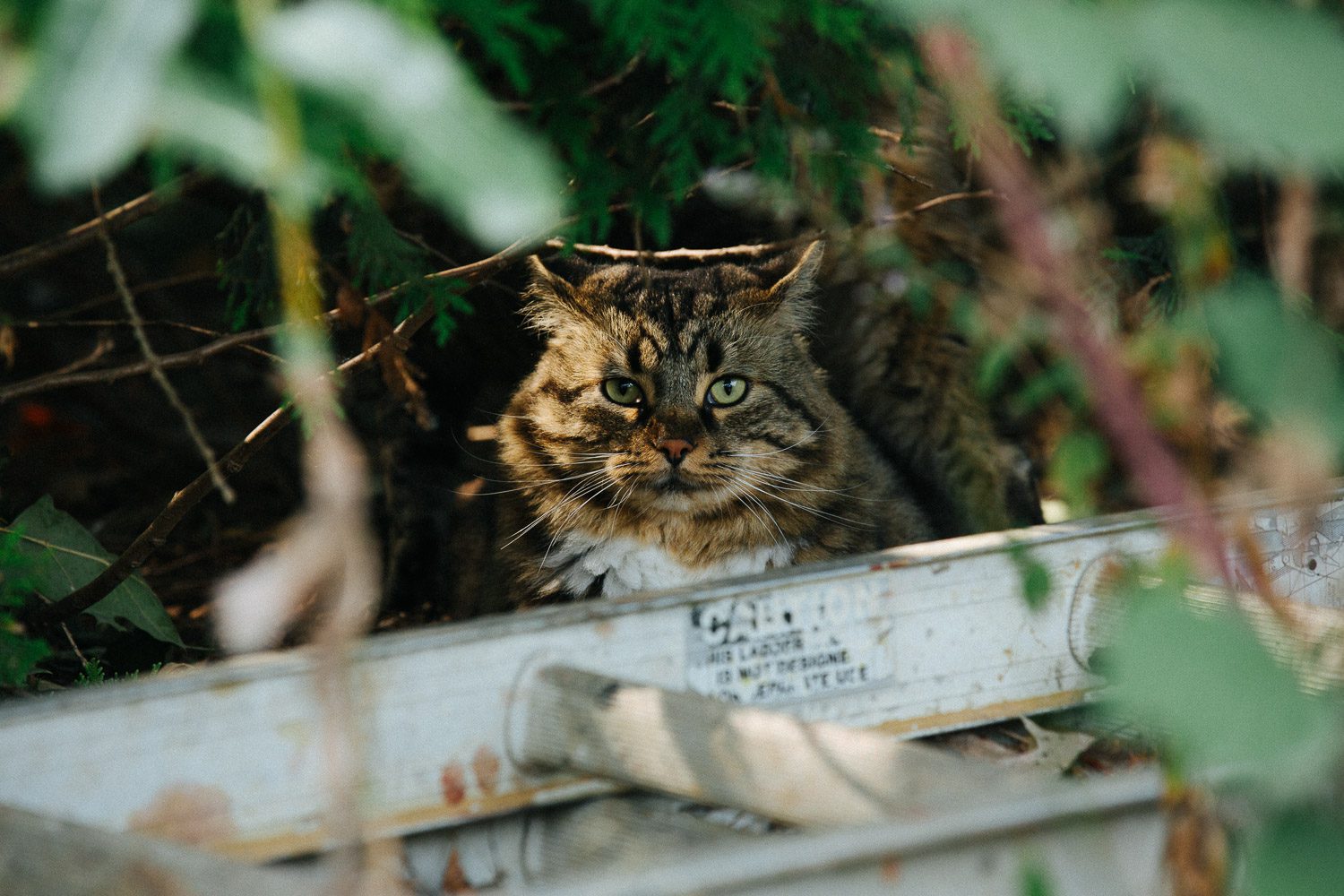
Spay or neuter your own pet: Female cats have a quick reproductive cycle, and cat populations can boom in a very short amount of time. The first step is always to ensure your own pets are spayed and neutered. In addition, we recommend keeping your cat indoors – not only for their own safety, but also to prevent them from catching and spreading diseases or getting lost and ending up part of a feral colony. We have a lot of great tips for how to keep your indoor cat happy and healthy.
Learn more about
Make your cat or kitten’s visit to the vet as stress-free as possible. Start with treats and a favourite towel, and take your time getting him or her out of their carrier. To learn more tips, read our care sheet (PDF) and watch our video:
Sometimes it’s hard to tell if your cat is sick or injured. The signs that she’s sick might not be obvious. Cats have evolved to try and conceal when they are sick. Watch for the signs below and call your vet if you’re not sure. Make sure your cat has regular vet exams to prevent illness.

Signs of illness in cats:
- Hiding, decreased energy, or other behavioural changes
- Changes in grooming patterns
- Changes in litter box usage (going outside the box, straining, etc)
- Increase or decrease in appetite or drinking
- Weight loss or weight gain
- Changes in sleeping patterns
- Bad breath
- Sitting hunched over
- Obvious illness or injury: vomiting, diarrhea, coughing, sneezing, wounds, limping etc.
Help a cat in our care receive a health check:
Thinking of getting a second cat? Below are some tips for introducing your new cat to your resident cat (PDF).
Go slow with cats!
When bringing a new cat home to meet your resident cat, it’s never a good idea to just throw them into a room together. That can be scary for both of them! Go slow and introduce them. For both animals this can be a stressful time. A gradual introduction process is important for them to build a friendship. If one cat gets hissed at or swatted, she may always be afraid of the other cat.
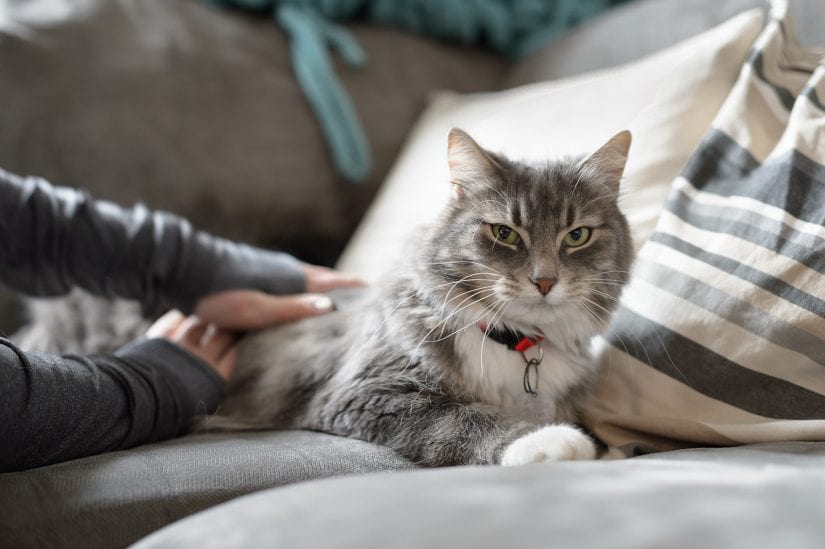
Step 1.) Before you take your new cat home
- Set aside one room for your new cat away from the resident cat’s favourite place.
- Have at least one comfortable sleeping area, one hiding area such as her carrier box, crate or a “tent bed”, a litter box, a water bowl and a food bowl.
- Plug-in a Feliway® diffuser. You can get one at your veterinarian office. It reproduces cat facial pheromones that are pacifying to cats. It will help lower their stress. It’s a good idea to have a diffuser in the new cat room and somewhere in the house where the resident cat spends time.
Step 2.) Bringing your new cat home
- Cats feel safe when surrounded by their own scent. Place towel or bedding she has been sleeping on in the carrier box so that she has familiar scent during the trip.
- Once home, take your cat to her room right away. Do not come into contact with the resident cat.
- Keep her inside the carrier box until you are in her room with the door shut.
- Place her box or other hiding area in a corner of the room (away from the litter box) and place the carrier box beside it. Open the door.
- Do not force her to come out. She may be scared and stressed by the new environment.
- Leave her alone in the room. Allow her to settle down and come out on her own.
Step 3.) Later that day swap cats scent
Cats communicate visually but also by scent. So you must start by introducing the cats to each other by “swapping “scent.
- Place your new cat’s towel on or near your resident cat’s favourite place and encourage him to approach
- If your cat starts to hiss, spit or avoid the towel place it on the floor away from his bed or food bowl. Each day move the towel closer to the cat’s food bowl.
- Do the same thing with your resident cat’s bedding giving it to the new cat for her to smell.
- Swap food bowls between the cats. They will start to associate the positive act of eating with the scent of the other cat. If one of the cats is sick or on a special diet, ask your vet before trying this.
- Once they are completely tolerant of each others scent proceed to visual contact.
How long will it take for cats to like each others scent?
This can vary from a few hours (usually when one is a kitten or both are social cats) to a few months.
Important tip when introducing cats
Set aside special play and petting time each day. You want to have one on one time with each cat when your introduction is taking longer.
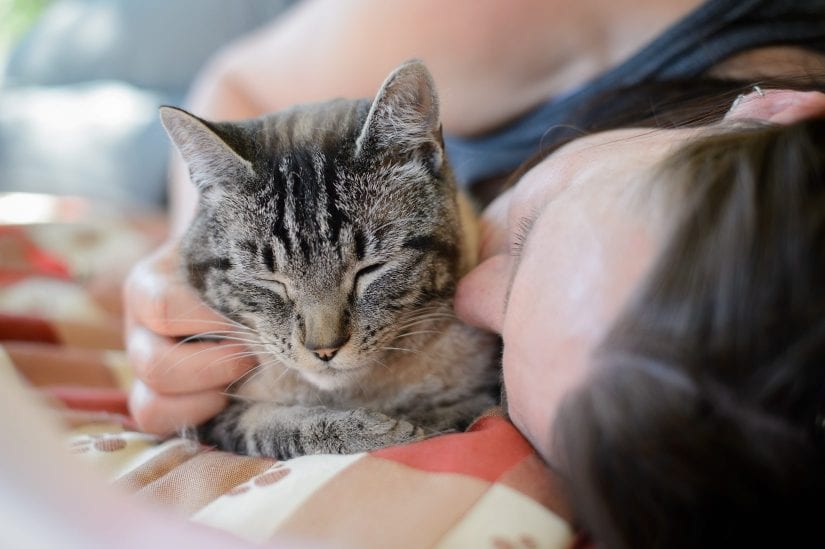
Step 4.) Controlled cat meetings
First – Visual contact between cats
- Separate physically with screen door or baby gate. If not possible then open new cat’s door slightly so cats can see each other but cannot fit through door.
- Give cats treats so they spend time close to each other or play with a feather to encourage play. Do not use catnip.
- When comfortable with each other they will sniff noses, play through the door or rub against the door. When you see this, you can have a proper introduction. There should be no growling, or repeated spitting or hissing.
What if my cats are showing aggression towards each other?
Is the aggression more severe than a hiss or a quick swat? Make the opening smaller and over the next few days, feed the cats closer and closer to the door.
Second – No barrier between cats
- Open the door and let them explore.
- If they fight, interrupt them by clapping your hands or with another noise that doesn’t scare them.
- Don’t pick them up or force them to interact.
- Let them distance themselves from each other if that’s what they want.
Do they each need their own litter box?
Give each cat his or her own litter box and add an extra one. They should have their own bowls, beds and hiding places unless they choose to share.
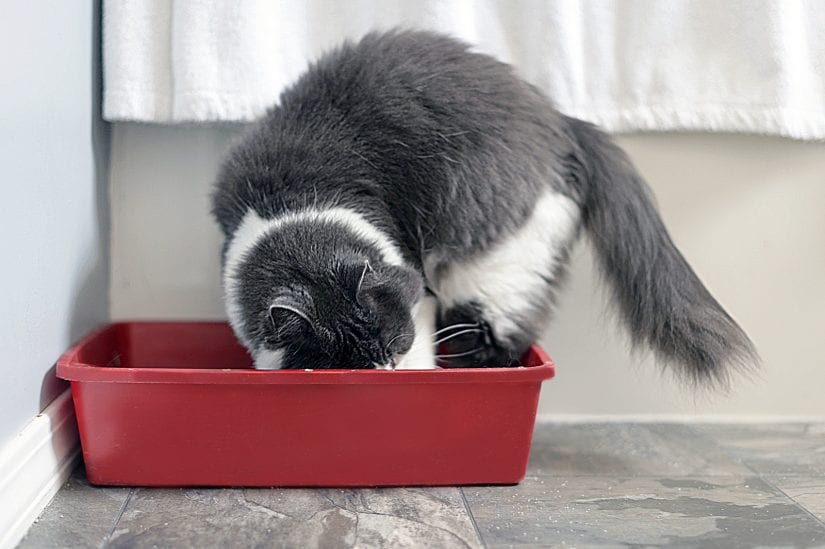
Expectations
Introductions, when done properly, can take more time than expected. Introductions and building a relationship for some cats may take a few hours or up to a few months. Your cats may play and groom each other or just sit and watch each other. Don’t force them to be what you think best buddies act like.
Caution when introducing cats
Watch for bullying, sometimes one cat will not let the other one through a door, or have access to the food bowl. You may see them swatting or hissing when the other cat tries to go to the food bowl. Watch for signs one cat is avoiding areas. If you think she’s being bullied make sure she has her own space and things like bed, litter box, food bowl.
Never punish either cat if they show aggression. If you see, signs of aggression go back a few steps. Scent swap for a few days and start visual contact slowly again.
When to contact your vet about introducing cats?
- Prolonged fighting
- Injuries from fighting
- One cat stops eating
- One cat stops using the litter box
- One starts spraying
- One of your cats hides all the time
Adapted from cat behaviour research by Dr. Rachel Casey, Anthrozoology Institute, UK

Cats are not born knowing how to use a litter box. Kittens learn about the bathroom from mom. When we give them a plastic box with litter in it we have to teach them to use this as their bathroom.
Pet your cat, give a him a treat or engage in a play session every time he uses the litter box. Never punish your cat or scare him for inappropriate elimination.
Not using a litter box is one of the most common cat behaviour issues guardians deal with. Recognize when there is an issue and try to solve it. Your cat may stop using the litter box for medical, behavioural or emotional reasons.
Steps to litter train (house train) your cat
1.) Location of cat litter box
Put the litter box in a convenient and quiet area for your cat. Make sure the litter box is the right size and type for your cat. The rule of thumb is that a litter box should be one and half times the length of your cat. Go bigger if you’re not sure!
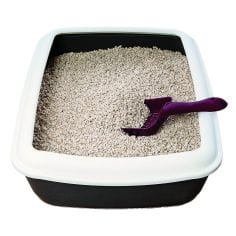 2.) Type of cat litter
2.) Type of cat litter
Most cats prefer soft small grained litter. Your cat may prefer one litter over another, so when you find what he likes, stick with it. One way to see what he likes is to put several litter boxes out with different litter and let him choose.
If you have multiple cats you should have one litter box per cat, plus one extra.
3.) Take your cat to the litter box
Take him to his litter box after meals and naps until he gets the idea. If his box is in a separate room, put him in the room and close the door after meals and naps.
4.) Use treats to train your cat
Give him a treat after he uses his litter box.
5.) Cleaning your cat’s litter box
Scoop litter box daily and depending on the litter you use wash box every one to two weeks.
6.) No bad cats
If your cat has an accident never yell or hit him. Go back to step one or check out “My cat won’t use the litter box, what should I do?”.
It’s important to remember your cat’s litter box is a big part of her life. Keep it clean so that she enjoys using it. Learn about cat litter box maintenance.
Need more information? Download Litter box problems treating and reducing cat inappropriate elimination (PDF).
Register your pet’s microchip, tattoo or license with the BC Pet Registry. Submitting your pet’s information to this provincial database ensures your pet is traceable by all participating veterinarians, animal control agencies and humane societies.
Find out more about how permanent pet ID can help ensure peace of mind.
Update Your Information
Have you moved or changed your phone number? Keeping your contact information up-to-date is easy with the BC Pet Registry. Registered users can also add additional forms of ID to their existing pet profile free of charge.
To report a lost pet, please contact your nearest BC SPCA branch.
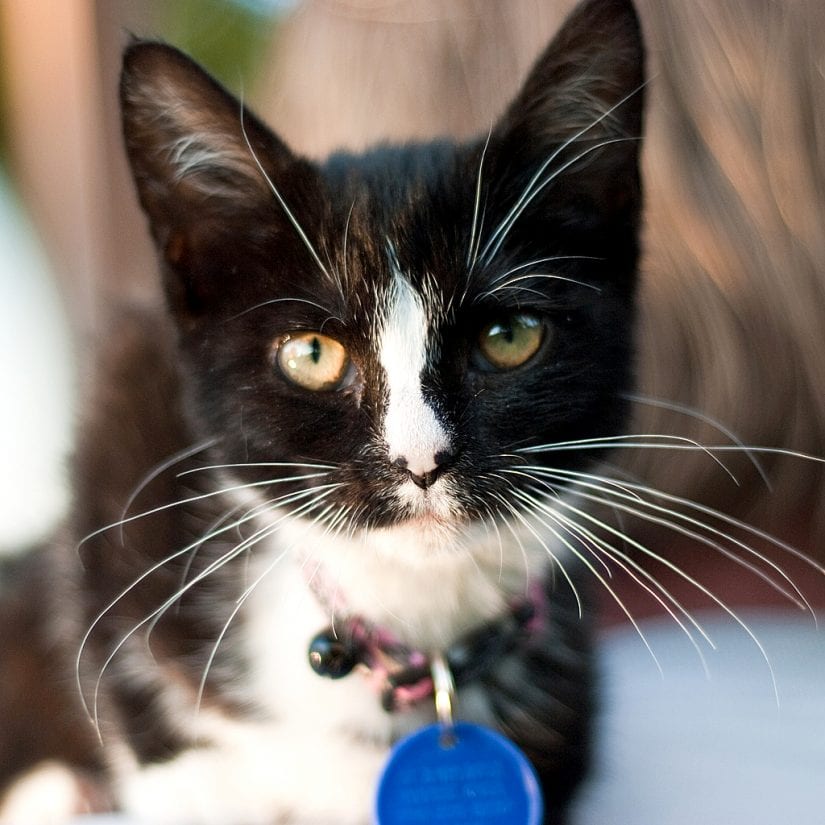
Walking your cat on a leash
Many cats like going outside and one way to keep them safe is to teach them to walk on a leash. Before you take them outside, get them used to wearing a harness. Most cats have never had something wrapped around their body like a dog has. Don’t force them to wear the harness, teach them to want to wear it by learning the best way to put a harness on a cat.
Once your cat likes the harness, then start taking them outside for short visits to quiet places. If your cat has never been outside before, this could be scary for them. Always take a pet carrier with you so your cat can jump in and hide if they’re scared.
Don’t forget to make sure your cat has ID before taking them outside! We recommend that all cats have a microchip, plus a visible form of ID such as an ear tattoo or a breakaway collar with an ID tag.

Signs your cat is ok on harness and leash
- Relaxed body
- Exploring and interested in area
- Showing friendly behaviour
- Walks a little bit and then lays down or explores
Signs your cat may be scared
- Body pulled tight like they’re trying to make themselves smaller
- Trying to hide
- Refusing to walk, laying down trying to make themselves smaller
- Ears back, hissing, vocalizing
- Jumping or shaking because of sounds or people
Never force your cat
- To walk by dragging them on a leash
- To stay outside if they’re scared all the time
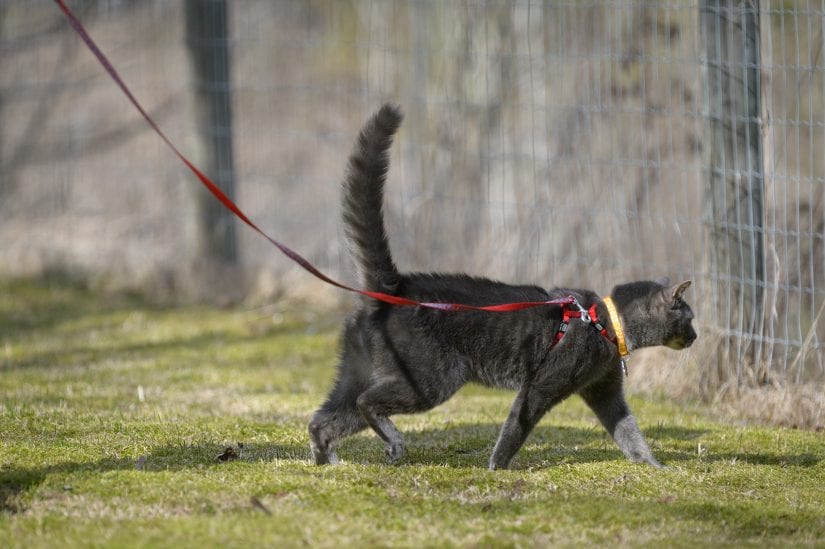
Transitioning an outdoor cat to an indoor cat can be stressful. For the well-being of everyone involved it is best when done gradually. Start by allowing them free access to the indoors at any point in the day. Make the home as enjoyable as possible with toys, scratching posts, plants and more (check out our “DIY Cat Enrichment” (PDF) for some ideas). The goal is to make the the inside of your home as fun as possible to decrease any stress your cat will be feeling.
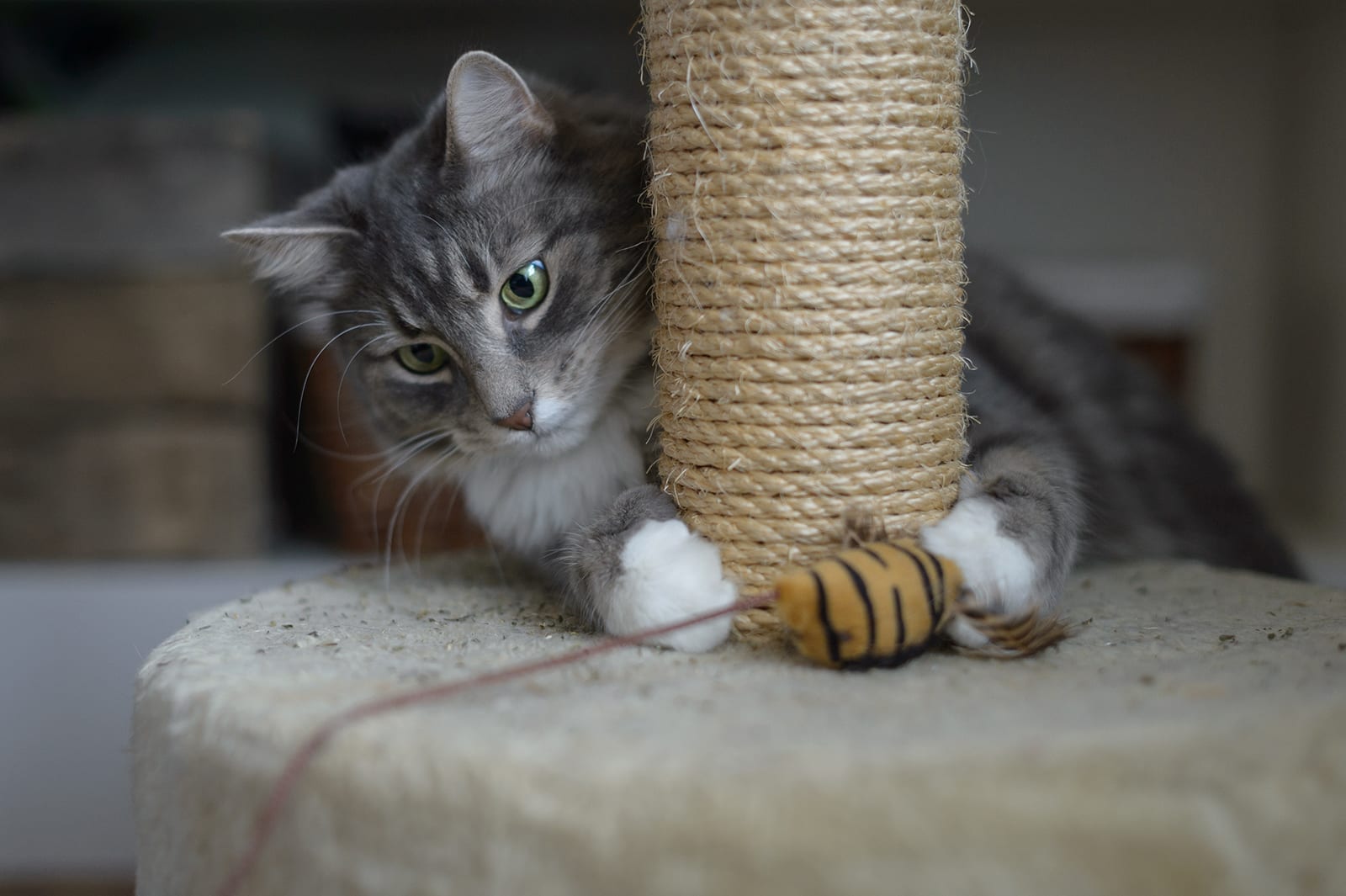
Additionally, you can encourage your cat’s hunting instincts inside the home by feeding them with food puzzles and playing with toys designed to mimic the movements of birds and mice. Outdoors, cats have the opportunity to climb and perch. In order to provide a similar environment inside, add scratching posts, cat trees and perches near doors or windows where they can see outside.
It’s important that a cat has the opportunity to express their innate behaviours when they are kept indoors. A catio is the perfect way to help transition an outdoor cat into the home as it provides the stimulation of an outdoor environment while protected. We have step-by-step guides to help you build a catio.
If your cat is still showing signs of wanting to go outdoors, leash-train your cat and enjoy walks together.

Is your pet’s microchip, tattoo or license registered with the BC Pet Registry? Updates can be made at any time. Registered users can also add additional forms of identification (ID) to their pet profile.
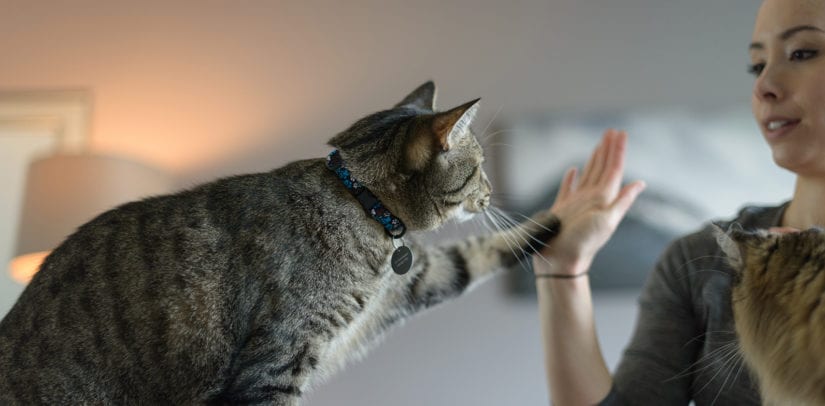
Contact your veterinarian
Call your veterinary clinic so they can update their records. You can also register your pet’s tattoo with the BC Pet Registry.
Contact your municipal animal control office
In most municipalities, you must license your dog. Contact your local animal control office (e.g. City of Vancouver Animal Control) to update your phone number, address or family members on file. You can also register your pet’s municipal license with the BC Pet Registry.

Cats are wonderful companions and giving a cat a home is a wonderful event, but it is important to remember that cats can be very timid and afraid when transitioning into a new home. When you arrive home, go straight to a small room where your cat can stay for a few days. There should be no places to hide in this room except for a crate or their carrier box.
The room should have a litter box, food and water bowls. Cats do not like to eat near their litter box so keep the food bowls and the litter box away from each other.

Tips for introducing your cat to her room
- Open the crate or setup the Hide, Perch & Go™ box you got from the BC SPCA and let your cat out. Let her explore the room.
- Place the crate near a wall.
- Sit on the floor and quietly observe.
- Your cat may come to you right away or go in her crate. Do not hold, restrain or force her to do anything.
Leave your cat in the room. You’re excited, though being patient for a few days is the best and most loving thing you can do.
Remember a new cat coming from an animal centre may have just experienced a difficult time in their life. They have lost their home and routine. Give your cat the time and space she needs to get used to you and her new surroundings.
Step 1
- Go to the room as often as you can.
- Bring gifts such as healthy and tasty food treats or toys (e.g. feather stick, cat ball) every visit.
- Every person in the household should take a turn doing this.
- Sit on the floor and place these treats near you or wave the toy around.
Step 2
- Wait for your cat to come to you – DO NOT grab or attempt to hold the cat.
- Talk to her – a high-pitched but quiet voice is always more reassuring for cats.
- Try coaxing her out.
- If she comes to you, pet her gently under the chin.
Every cat is different. Some may show you love and climb on your lap right away. Others may stay in hiding and watch you from afar until they feel safe. Take your cues from your cat. Let her make the decision of how much interaction she’s comfortable with her. The adjustment may take hours, days or even weeks. For more tips download our our care sheet (PDF).

Most cats love to stretch and scratch something. Scratching is important for cats — it’s a natural behaviour. Scratching also helps shed the outer covering on their claws and scent mark.
Instead of trying to stop them from scratching, give them something to scratch (PDF). Put scratching posts close to an entrance or near where your cat sleeps. They usually stretch and scratch after waking up or when entering a room.
If they’re using your couch as a scratching post, interrupt them. Don’t scare them. Make sure to reward them for scratching their post.
Never use harsh verbal or physical corrections with your pet. If you feel like nothing is helping, talk to your vet about safe and humane nail covers.

Declawing cats
The BC SPCA is against declawing cats. A cat’s nails are not like fingernails — they’re attached to the bone. Therefore, declawing is a serious surgery. It’s like removing a part of your finger at the knuckle. Read the BC SPCA position statement on cosmetic and other non-therapeutic alterations (PDF).
The practice of declawing cats is now banned in B.C., unless it’s deemed necessary as an appropriate medical therapy.
To learn more, watch our video on cats and scratching:
When there’s a new kitten at home, it can be tempting to play with her with your hands – don’t! Your cute kitten will grow into an adult cat who might think biting your hands is a natural, normal thing to do. Instead, use big stuffed toys and wand toys to teach your kitten to play with their toys and not your hands and arms. Learn more, watch our video:
Spaying or neutering your dog, cat or rabbit doesn’t just help prevent accidental litters. It also has health and behavioural benefits for your pet.
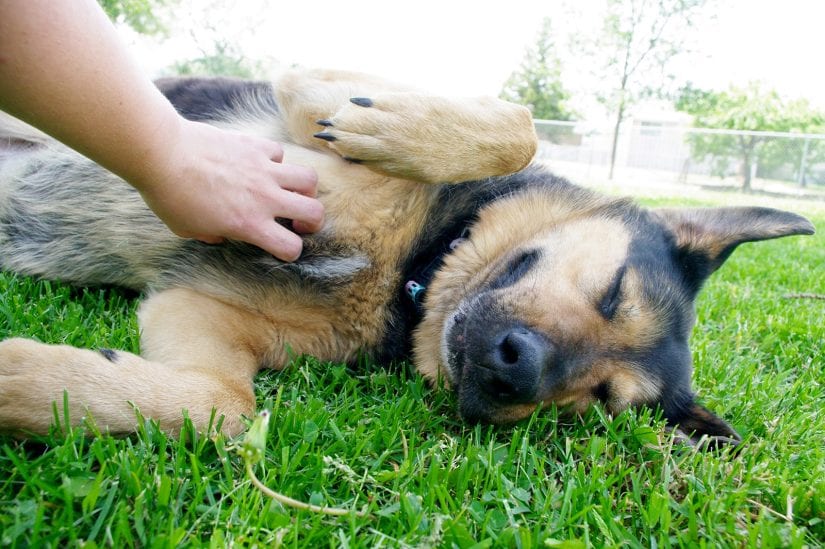
Benefits of spaying and neutering your pet
Generally, neutering decreases aggressive behaviours in pets
- Neutered dogs are calmer and less likely to bite, attack or get into dog fights.
- Neutered cats and rabbits don’t have the drive to mark and protect their territories and are less likely to spray or get into fights, resulting in fewer injuries.
Spaying ends the heat cycle in females
- Heat cycles are usually twice a year for dogs, and result in many unwanted behavioural changes including possible aggression.
- Cats generally go in and out of heat every three weeks between January and November.
- Female cats in heat can howl relentlessly, may try to escape to mate, spray or urinate inappropriately and attract unwanted male cats.
Spaying and neutering lowers the chance of reproductive health problems
- Studies show that spayed/neutered pets, on average, live longer.
- Spaying eliminates the risk of ovarian and uterine cancer and pyometra (life-threatening infection of the uterus) in dogs, cats, and rabbits. Up to 80% of unspayed rabbits will develop uterine cancer.
- Spaying reduces the risk of mammary cancer in cats, dogs, and rabbits.
- Neutering eliminates the risk of testicular cancer in all species and lowers the risk of prostate problems in male dogs.

Spaying and neutering eliminates the drive to reproduce
- The likelihood of your male pet wandering away or escaping will be decreased.
- Male dogs can smell a female in heat up to a kilometre away.
- Once neutered, your pet will be less frustrated and may become a calmer companion.
Spaying and neutering provides an opportunity to have other important procedures performed
- Other procedures, as necessary, can also be done at the time of the operation.
- This includes procedures such as an identification tattoo or microchip, teeth cleaning, hernia repair and baby teeth removal.
Spaying and neutering prevents accidental pregnancies
- Research shows that the majority of cat pregnancies are unintended.
- Pregnancy is hard on the mom physically. Prenatal care, birth complications, and puppy/kitten care can be costly.
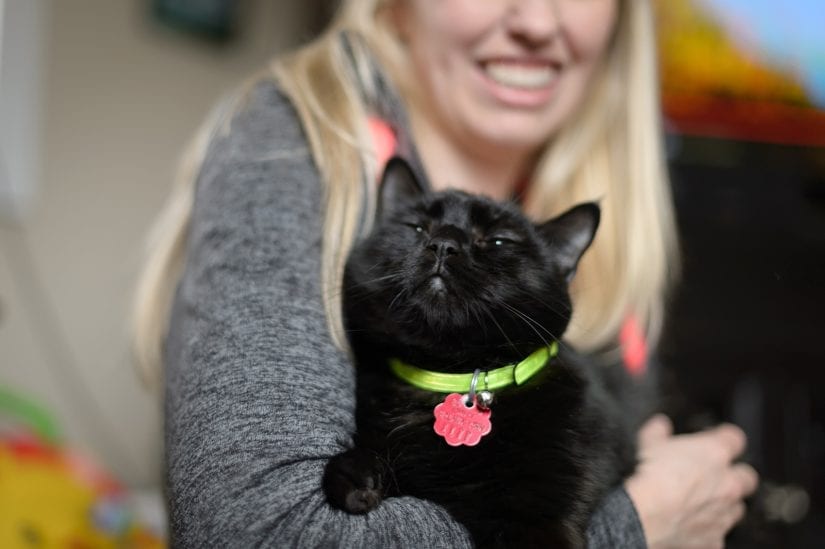
Spaying and neutering helps your community
- Research shows that, as an individual, you help reduce overpopulation issues in your community when you spay or neuter your pet.
- Spaying and neutering your pet helps reduce the number of stray or unwanted animals in your community.
- Reducing the amount of stray animals helps prevent other pets and wildlife from being injured or killed in fights.
- Fixing your pet helps lessen the amount of stray animals getting into or causing car accidents, getting into garbage cans and damaging property.
Learn how fixing your cat helps combat the cat overpopulation problem and how you can take action in your community.
But aren’t there also some risks to spaying and neutering?
Yes, any surgical procedure carries some risks. However, the overall benefit outweighs the risk for most animals. Talk to your veterinarian about the best choice for your pet.
- Risks of surgery and anesthesia include pain, bleeding, infection, the incision opening up, or a bad reaction to the drugs used.
- Spaying and neutering removes reproductive hormones from your pet’s body. This has many benefits but also has minor effects on bone development and other body systems.
- Several recent studies show higher rates of some bone and joint problems and cancers in purebred dogs spayed and neutered as puppies. These studies have attracted a lot of attention.
- The studies involved small numbers of dogs who were already predisposed to the problems being studied because of their breeds. More research is needed to understand these risks.
- If you are concerned about risks of spaying and neutering, don’t just consult the internet. Talk to your veterinarian about what is best for your pet.

I still have questions about spaying and neutering
Shouldn’t a female cat/dog have a litter before being spayed?
Will spaying/neutering change my pets personality?
Will my pet become fat/lazy once it is fixed?
What does spay or neuter mean?
When should my cat/dog/animal be fixed?
What does it cost to spay/neuter my cat/dog/animal?
Find out more about the benefits of sterilizing your pet and how February is spay/neuter awareness month.
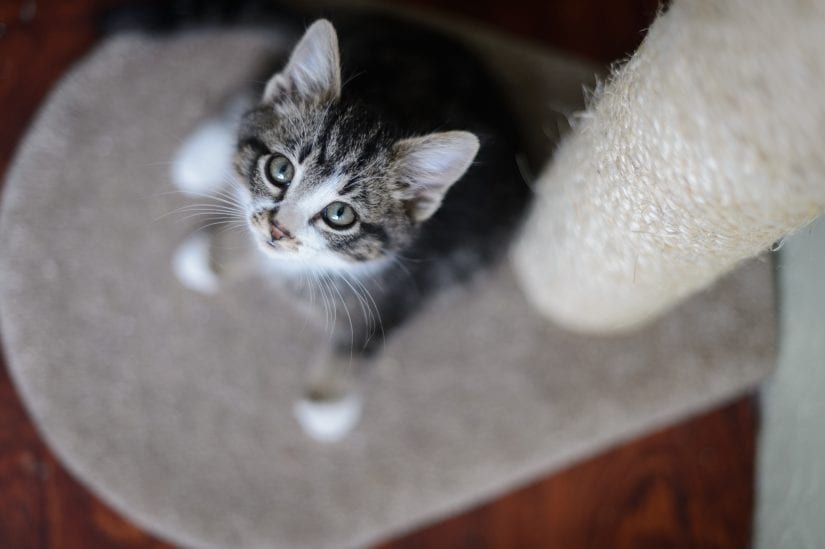
The BC SPCA recognizes that pet-friendly housing is limited in B.C. To make it easier to work together to create humane communities, we have developed resources to help renters demonstrate themselves as responsible guardians and assist strata councils and property owners in effectively managing their buildings and suites.

Learn more about finding pet-friendly housing for you and your pet.
Start with determining their age, then decide if you should leave them with mom, take them in, or call the BC SPCA. If they are very young, it’s safest to leave them in place until you can determine whether their mom is still caring for them. If you do take them in, their care will depend on their age.
Learn when to wait, when to act and how to care for kittens you find, watch our video:
Most antifreeze is made from ethylene glycol. Ethylene glycol-based antifreeze tastes sweet but is highly toxic to both humans and animals. To help protect pets, wildlife and children, the provincial government passed a regulation that requires the addition of a bittering agent to all antifreeze sold at the consumer level in British Columbia. The regulation, the first of its kind in Canada, took effect in 2011.
While a bittering agent may make antifreeze less appealing, ethylene glycol is still harmful, even in small amounts. Consumers should be encouraged to use antifreeze made from propylene glycol instead. Propylene glycol-based antifreeze is slightly more expensive, but is considered non-toxic to pets and wildlife.
Antifreeze facts
- Antifreeze is the brightly coloured liquid that is poured into radiators and circulates through engines to keep them operating at safe temperatures.
- All cars, trucks, buses and farm tractors use antifreeze to help prevent their engines from freezing over in the winter and overheating in the summer.
- Conventional antifreeze contains ethylene glycol, which is very poisonous to people and animals.
- Even in the smallest amounts, antifreeze can have a very harmful and often fatal effect on your pet. A single teaspoon will kill a cat and a few tablespoons are enough to kill a medium-sized dog.
- Antifreeze leaks from automobiles and is spilled in garages and onto pavement due to careless fluid changes.
- In some instances, antifreeze has been used to deliberately poison animals as an act of cruelty.

What do I do if my pet consumes antifreeze?
Animals who have ingested antifreeze go through two stages of symptoms. If untreated, death from kidney failure will occur within days.
If you suspect your animal has ingested antifreeze, seek veterinary aid immediately. YOUR PET WILL NOT RECOVER ON THEIR OWN. Time is critical as within minutes your pet will begin to experience kidney damage. Learn what to do if your pet has consumed antifreeze.

Use animal-friendly antifreeze
Fortunately, there is a less toxic alternative to the ethylene glycol-based antifreeze that is most commonly used. Animal-friendly antifreeze contains propylene glycol and is anti-corrosive, biodegradable and recyclable. This makes it a better choice for the safety of pets and wildlife, personal health, vehicle engine protection and the environment. It may cost a few dollars more but it could save lives. Make the switch today!
Customers can request pet-friendly propylene glycol antifreeze from their automotive service centre or purchase it separately and ask that their auto centre to install the product.
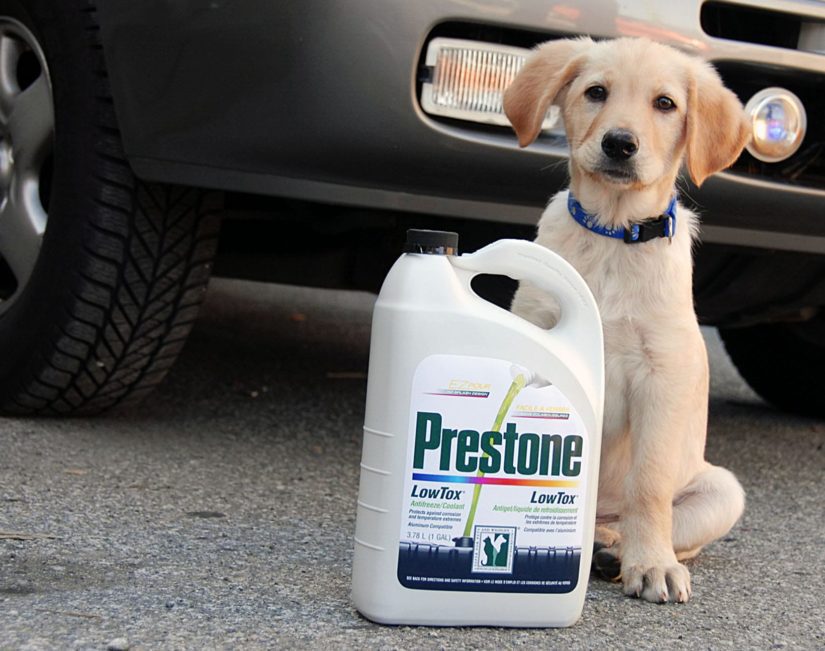
What can I do to help?
- Download our poster today and help spread the word! (PDF)
- Mop up spills and dispose of antifreeze properly.
- Take used ethylene glycol or propylene glycol antifreeze to an auto centre that recycles antifreeze.
- Never pour any used antifreeze (ethylene glycol or propylene glycol) down storm drains, sinks, toilets or on the ground. B.C. has a network of collection facilities that accept used antifreeze (ethylene glycol and propylene glycol), oil, oil filters and oil and antifreeze containers at no charge. Visit the B.C. Used Oil Management Association website to find a location near you or contact the Recycling Council of B.C. at 1-800-667-4321 for a list of outlets.
- Find out more about cold weather pet safety and how to keep your furry family members safe during cold weather.
 Act quickly! If you suspect your pet has consumed antifreeze you must take your pet to a veterinarian immediately. Animals who have ingested antifreeze go through two stages of symptoms. If untreated, death from kidney failure will occur within days.
Act quickly! If you suspect your pet has consumed antifreeze you must take your pet to a veterinarian immediately. Animals who have ingested antifreeze go through two stages of symptoms. If untreated, death from kidney failure will occur within days.
Stage 1
In the first hour after drinking antifreeze, animals will stagger, act uncoordinated or disorientated, possibly bumping into things. They may also try to vomit. The quicker you get to the vet the better chance your pet can be successfully treated.
Stage 2
After stage 1 it may appear your pet has recovered. However, in this stage the antifreeze is being processed by the liver, creating substances that cause permanent kidney damage as well as signs of central nervous system damage. The more antifreeze the pet has ingested the more damage. Eventually the animal will lapse into a coma. Death usually occurs within 48 hours.
Veterinary care
Immediate treatment is critical. If you suspect your pet has been poisoned, take your pet to a veterinarian. Your pet will NOT recover without treatment.
Learn about pet-friendly antifreeze
Congratulations! Cats are wonderful companions and giving a cat a home is a wonderful event. A new home with new smells, people and furniture means your cat may feel anxious, stressed and scared.
How to help your new cat adjust to her new home
When you arrive home, go straight to a small room where the cat can stay for a few days. There should be no places to hide in this room except for a crate. The room should have a litter box, food and water bowls. Cats do not like to eat near their litter box so keep the food bowls and the litter box away from each other.
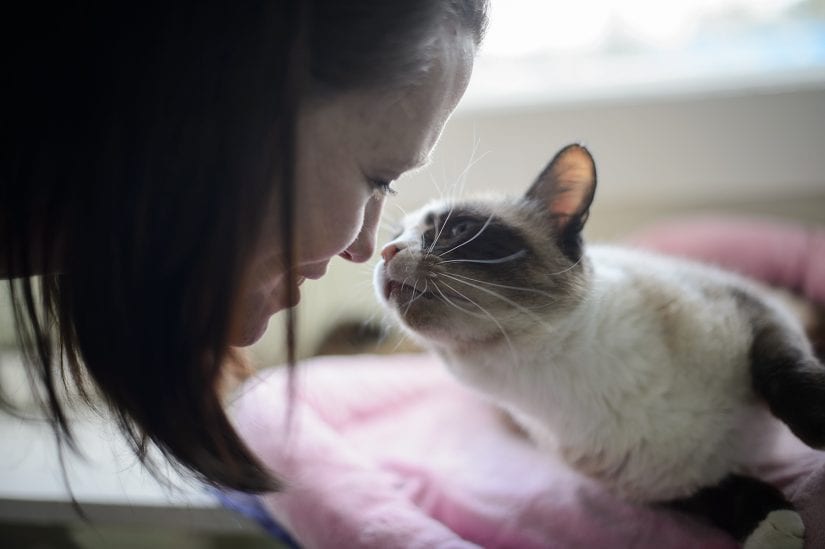
Tips for introducing your cat to her room
- Open the crate and let your cat out. Let her explore the room.
- Place the crate near a wall.
- Sit on the floor and quietly observe.
- Your cat may come to you right away or go in her crate. Do not hold, restrain or force her to do anything
How to help your new cat bond with you
Leave your cat in the room. You may be excited but being patient for a few days is the best and most loving thing you can do.
Remember a new cat coming from another home or animal rescue, may have just experienced a difficult time in their life. They have lost their home and routine. Give your cat the time and space she needs to get used to you and her new surroundings.

Step 1
- Go to the room as often as you can.
- Bring gifts such as healthy and tasty food treats or toys (e.g. feather stick, cat ball) every visit.
- Every person in the household should take a turn doing this.
- Sit on the floor and place these treats near you or wave the toy around.
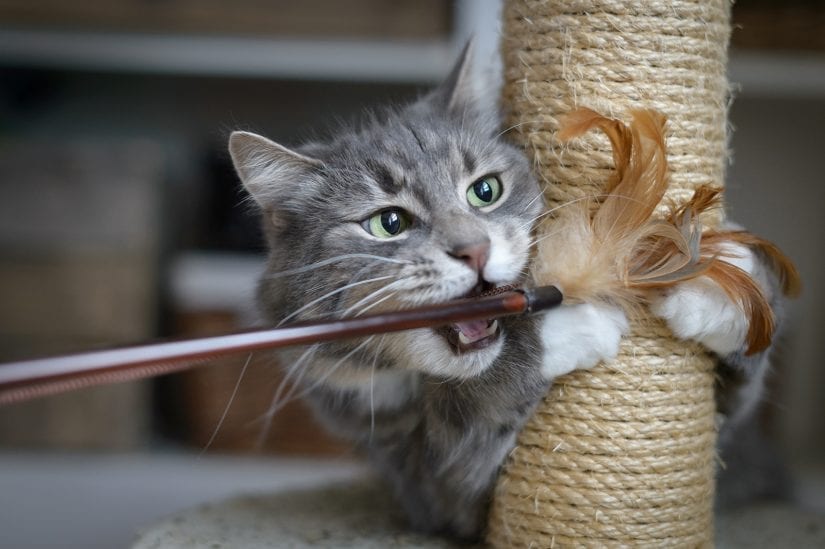
Step 2
- Wait for your cat to come to you – DO NOT grab or attempt to hold the cat.
- Talk to her – a high-pitched but quiet voice is always more reassuring for cats.
- Try coaxing her out.
- If she comes to you, pet her gently under the chin.
Every cat is different. Some may show you love and climb on your lap right away. Others may stay in hiding and watch you from afar until they feel safe. Take your cues from your cat. Let her make the decision about how much interaction she’s comfortable with. The adjustment may take hours, days or even weeks.
Learn more about how you can welcome home your new cat and bond with them (PDF).
Sometimes, cats don’t like being petted, or they’ll allow it for a little bit, then bite or scratch. Teach your cat to like being petted using treats and their food. They’re not born liking being petted or touched, but we can teach them.
Learn more about how to pet a cat, watch our video and read our article:
To understand more about petting aggression, download Petting aggression when it comes to petting, not all cats are created equal (PDF).
Is this new behaviour?
Cats learn where to go to the bathroom and how to cover it as kittens. It’s easy to teach cats to use a litter box because they want to be able to bury their waste. If they stop using their box it’s a concern. They don’t stop out of spite or disinterest; there’s always a reason.
Have you taken your cat to see a vet?
If not, get him checked by a vet, especially if he’s always used his litter box and now he refuses to use it. If so, and if your vet says he’s healthy, ask how you can help your cat or for a referral to a professional.
Try these cat litter box tips:
1.) Location, location, location
Make sure the cat’s litter box is in a quiet location. Place it in a corner where no one can surprise or scare him and somewhere that isn’t busy. Keep it away from his food.
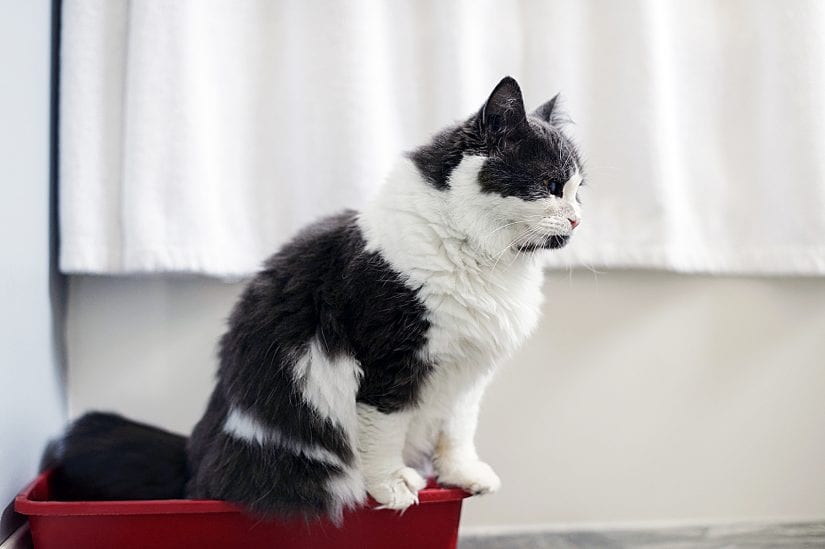
2.) Size does matter
What size is the right size litter box for your cat? Rule of thumb is litter box should be one and a half times longer than your cat. Go bigger if you’re not sure!
3.) Type of box
Think of what your cat needs, not what you prefer. A covered litter box holds the smell in, but this could prevent the cat from using his box. Boxes with high sides might be too difficult for older cats to get into or out of. Self-cleaning boxes might be too scary for some cats. And some cats don’t like plastic liners. A simple box at least four inches deep, the right length for your cat and without a cover is ideal.
4.) How many boxes
If you have more than one cat you should have a box for every cat, plus one extra.
5. ) Litter type
Try different types of litter to see what your cat likes. Put four litter boxes out with different types of litter and see which one he chooses most often. Try different amounts of litter in the box, as some like deep litter while others might not. Stop using the freshener you’ve been using and when you find a litter he likes, stick with it.
6.) Clean it
For many cats a clean litter box is important. Try scooping it twice a day and cleaning it once a week. Some cats may not use it if there’s anything in it.
7.) No bad cats
Remember, you may think your cat is being bad and doing it on purpose. This isn’t true! There is always a reason why your cat is missing the mark. Find out why and help him, never yell or spank your cat.
Find more on litter box issues in our fact sheet Litter box problems treating and reducing cat inappropriate elimination (PDF) and in this video on how to get your cat used to their litter box.
It’s always a good idea to look at the benefits and the costs when considering adopting a second kitten. A young kitten will do better with another kitten, but it will cost a bit more because you’ll have two. It’s not always extra work when you adopt two, but it is double the fun for you.
Find a second kitten through the BC SPCA’s adoptable animals page.
Learn more about adopting a second kitten, watch our video:
The BC SPCA recommends that cats live indoors. Indoor cats have a longer life span than those that go outside. Whether you choose to let your cat out or keep them in, know how to provide them with the best environment to keep them happy and safe.
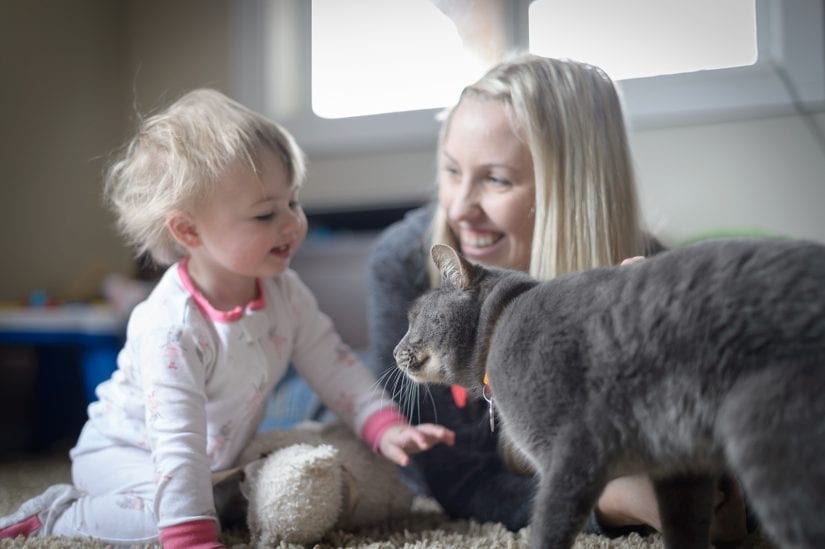
What’s the issue with indoor and outdoor cats?
Risks of letting your cat outdoors
- Other cats or dogs in the neighbourhood can cause injuries to your pet
- Busy streets and traffic can cause injury or death
- Exposure to contagious diseases and parasites
- Extreme weather issues
- Poisoning
- Pet theft
- Animal cruelty
- Eaten or injured by wildlife like coyotes, eagles or other predators
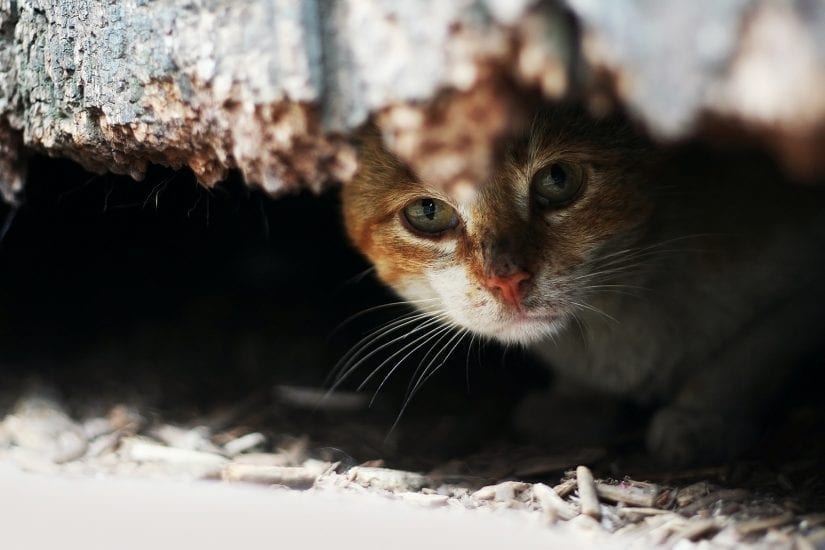
Outdoor roaming cats also cause
- Problems by digging in neighbour’s gardens
- Marking territory by spraying
- Prey on songbirds and other wildlife
Risks for indoor cats
- Depression
- Frustration
- Become lethargic if their environment does not provide enough stimulation
To prevent these issues, help your cat be a cat. Indoor cats need to do things in their home that let them hide, chase, climb, jump and pounce.

Tips to keep your cat happy, healthy and safe indoors
- Give your cat toys that are safe and stimulating.
- Use feathery and fake furry toys that move like small prey or toys filled with catnip.
- Rotate toys and new objects to ensure there’s always something novel
- Give your cat a scratching post with high perches. Put it near doorways or window.
- Spend time every day interacting with your cat. What does your cat like? Play or petting? Play with toys, games of chase and peek-a-boo. Train your cat.
- Cats need at least 15 to 30 minutes of play broken into short five minute sessions throughout the day.
- Plant a pot of indoor greens for your cat to munch on such as cat grass from seeds (oat, rye, wheat, barley) or catnip.
- Open screened windows to let fresh air in. Give her access to window ledges to sit on and look out at the world.
- Cats are auditory hunters. Be creative, get toys that make buzzing noises.
- Reward your cat when he hunts the sound.
- Use food puzzles! Cats normally have to work for their food through hunting. Food puzzles can be a nice substitute for hunting behaviour and provide lots of important cognitive stimulation for your kitty!
- Add a catio so your cat can go outside, keeping them and birds safe! And other safe outdoor access options.
- Provide multiple litter boxes of different sizes and litter types to do a preference test of what your cat likes best.
- Feed meals in smaller increments throughout the day to mimic hunting. Use enrichment feeding toys to make it a little more fun.
- Teach your cat to high five using positive reinforcement clicker training.

I want my cat to have some time outside
- Supervise your cat outdoors
- Train your cat to walk on a harness
- Build an enclosure outside to keep her safe
All cats need a collar and identification
Whether inside or out, your cat should always have a collar and ID tag as well as a tattoo or microchip. “Quick-release” or “break-away” collars with elastic are best. They’ll prevent your cat from getting tangled in branches or other objects.
We also recommend that you register your cat in the BC Pet Registry. This registration will enable any participating veterinarian, animal control agency or rescue group to identify the lost animal in their care and notify the guardians.

Tips to help keep your cat safe outside
Think about all the risks before deciding to let your cat go outside. It might be hard to change her habit of going out if you change your mind and want to keep her in.
- Train your cat to come back at a certain time every day by feeding her only then.
- Give your cat access to the inside of the house or a safe shelter near the house to escape other cats or dogs if one is chasing her.
- Train your cat to respond to a whistle by blowing the whistle every time you feed her or give her a treat. (Be careful as your cat may come running from across the street when she hears the whistle. You should not use the whistle unless you know it is safe).
- Talk to your vet about vaccines and parasite prevention.

Read more about indoor vs outdoor cats and how to enrich your cat’s life
Indoor versus outdoor – how to provide the best environment for your cat (PDF)
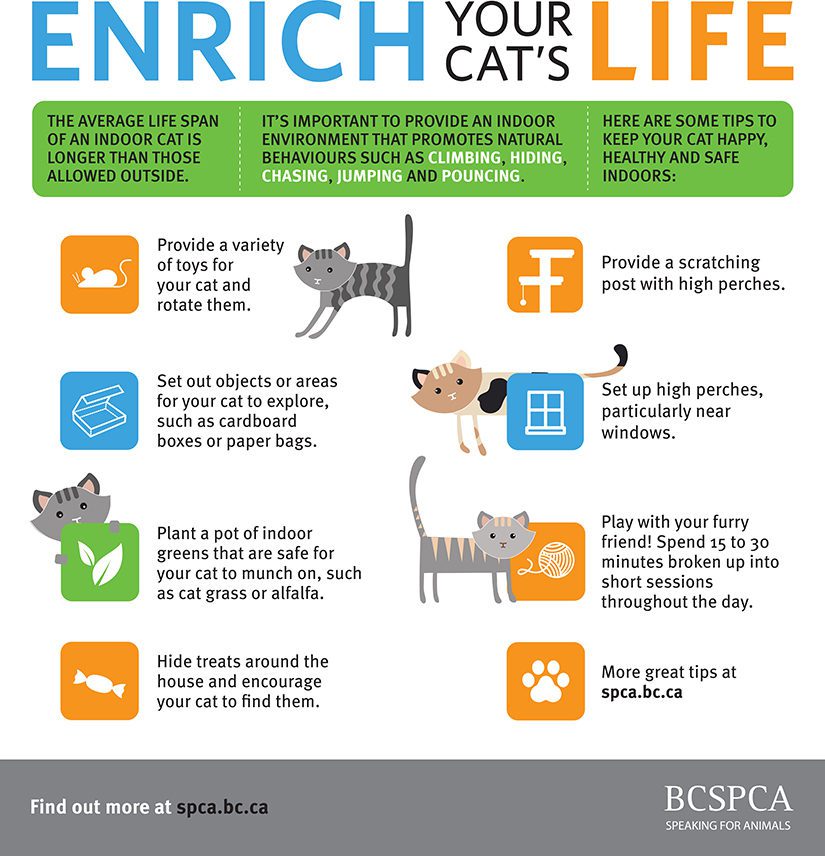
Allowing a female cat or dog to produce a litter does not have any benefits to the animal. Animals who go through heat cycles and pregnancy are at higher risk for uterine and mammary problems, including mammary cancer, which can be fatal.
There are health risks to the mother during the pregnancy and when giving birth. Proper pre-natal care, emergency care for birth complications, and proper newborn care are expensive and time-consuming.
Learn more about the benefits of spaying and neutering your pet.

If you are adopting your cat, dog or rabbit from the BC SPCA, spay/neuter is included in the adoption fee.
For other animals, the cost of spaying or neutering your pet depends on many factors and will vary according to each pet’s circumstances and needs. For example, a large dog will cost more than a small dog. If your pet is overweight or in heat this can also add to the cost. Contact your veterinarian to get a more accurate idea of the costs involved for your pet.

The cost of spaying/neutering is small when compared to other costs of pet care, such as what you will spend on food for your pet over their lifetime.
Consider the possible costs if you do not spay or neuter. If your pet should wander off in search of a mate, you may be faced with paying fines and impoundment fees. You may also be faced with the additional costs of caring for puppies or kittens for whom finding homes may be difficult. Worse yet, think of the costs should your pet be injured while roaming for a mate.
Spaying or neutering is a one-time investment with life-long health and welfare benefits for your companion.
If you require financial assistance, learn about low-cost spay/neuter programs in B.C.
Fostering an animal means you take a BC SPCA animal into your home and temporarily care for them for us. While they’re in your home, we provide you with food, supplies and medical care. Foster families help animals recover from illness/ injuries, get ready for adoption, and provide them with socialization and love.
If you are unsure about adopting an animal, or unable to make the commitment at this time, fostering can be a great way to bring animals into your life. You can also multiply your impact by caring for many animals during your time as an animal foster.
While fostering is temporary, many foster families fall in love with animals in their care. If an animal is available to be adopted, fosters can apply to be their forever home. In the case of emergency boarding, fosters feel proud of providing a safe temporary home for animals before they are reunited with their family.

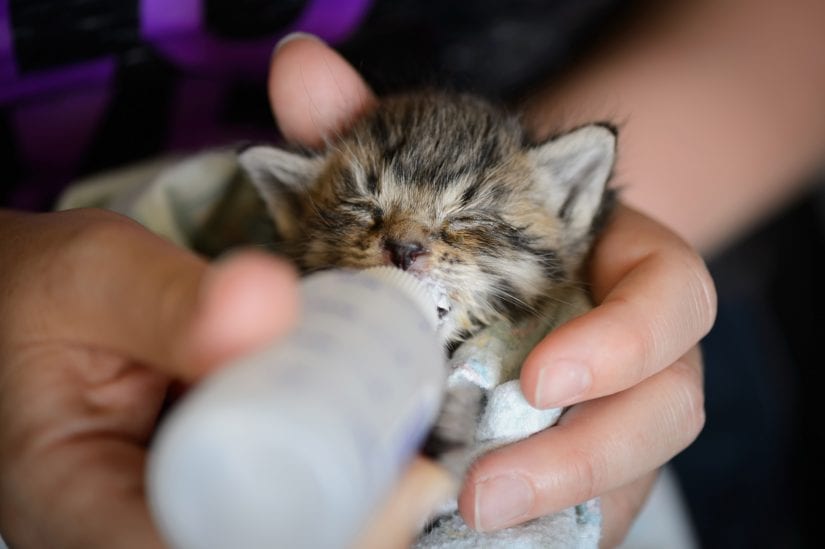
“Spaying” and “neutering” are surgical procedures used to prevent pets from reproducing. In a female animal, “spaying” consists of removing the ovaries or uterus and ovaries. The technical term is ovariectomy or ovariohysterectomy. For a male animal, “neutering” involves the removal of the testicles, and this is known as castration.
In addition to preventing unwanted offspring, spaying or neutering has many health and behavioural benefits to the animal.

To help cats cope with the stress of being at an animal centre, the BC SPCA developed the Hide, Perch & Go™ box. The box provides cats with more control over their limited environment and allows them to express behaviours such as hiding, perching and face rubbing (scent marking). All of these are natural cat behaviours that help reduce stress.
The Hide, Perch & Go™ box is included with the adoption of your new feline friend! Learn more.

What is the rabies virus?
Rabies is a viral disease of warm-blooded animals that can be transmitted to humans. It is caused by a virus of the Rhabdoviridae family, which attacks the central nervous system and eventually affects the brain. Rabies is almost always fatal in animals and people once symptoms occur.
How is rabies transmitted between animals and humans?
The virus is transmitted through close contact with the saliva of infected animals, most often by a bite or scratch. It can also be transmitted by licks on broken skin or mucous membranes, such as those in the eyes, nasal cavity or mouth. In very rare cases, person-to-person transmission has occurred when saliva droplets became aerial. Bat bites can inflict small wounds and go unnoticed.
Who is at risk of being infected by rabies?
Bats are the only known wild carrier of rabies in B.C. Like cats and dogs, raccoons, coyotes, skunks, farm animals, and any other mammals are capable of contracting the rabies virus, but are not considered carriers in B.C.
In other provinces like Ontario, raccoons, coyotes, skunks and foxes are wild carriers of rabies. In B.C., however, the only carrier of rabies is bats; no raccoons or skunks in B.C. have ever transmitted rabies.

How common is rabies in bats in B.C.?
It is estimated that one per cent of bats in the wild in B.C. carry rabies. In June 2004, four skunks in Stanley Park in Vancouver tested positive for the rabies virus. However, it was discovered that they all carried the bat strain of rabies; likely they had all been in contact with a rabid bat.
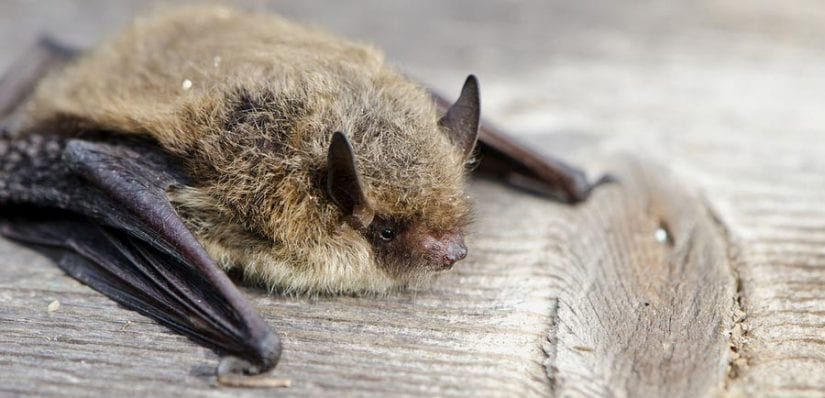
Cases of human rabies infection in Canada
In the past 25 years, five people in Canada have died of rabies infection: one in Quebec (2000), one in Alberta (2007), one in Ontario (2012) and two in British Columbia (2003 and 2019). In the Ontario case, rabies exposure occurred outside the country. These were the first cases of human rabies in Canada since 1985.
The most likely source of infection for both B.C. individuals was unrecognized bat exposure. Without wound cleansing or post-exposure vaccinations, the potential incidence of rabies in exposed humans can be very high.
Does my pet need a rabies vaccine?
Dogs and cats account for fewer than five per cent of all animal rabies cases in Canada. However, rabies presents a serious public health risk, and even indoor pets could come in contact with a bat. Some pets also need the vaccine for travel. Ask your vet whether your pet should be vaccinated.
What if my pet brings a bat home?
If your pet brings home a bat, you should take your pet to a veterinarian. If the bat is available, your vet may send it for rabies testing. Additionally, your vet may vaccinate your pet against rabies and/or ask you to keep your pet in your home for several months to see if they develop signs of rabies.
If any person in your household has touched a bat with bare skin, seek medical attention from a doctor or local public health unit immediately.
What will happen to the bat?
The bat may be euthanized and sent for testing. As of April 1, 2014, CFIA veterinary inspectors are no longer involved in species collection activities. However, the CFIA continues to perform and cover the cost for rabies laboratory testing involving domestic and wild animals and humans. This is vital as once the symptoms of rabies (flu-like including fever, headache and fatigue, progressing to gastrointestinal and central nervous system problems) start to appear, there is no treatment and the disease is almost always fatal. However, wound cleansing and immunizations, done as soon as possible after suspected contact with an animal, can prevent the onset of rabies in virtually 100 per cent of exposures.
What to do if there has been contact with a bat
Bat-to-person contact?
If treatment is given promptly after being exposed to (any bare skin contact) or bitten by a bat, the illness may be prevented by taking the following actions:
- Immediately wash the wound or exposed surface with soap and water for 10 minutes and cover the area with a clean bandage.
- Remove any clothing that may have been contaminated.
- Immediately call your doctor and local health authority for advice.
Bat-to-pet contact?
Please contact your veterinarian to have your pet vaccinated and discuss whether a period of isolation/observation is required for your pet. If the bat is available, your veterinarian may send it for rabies testing.
Found an injured bat?
No matter how injured, a bat should never be touched with bare hands. Please refrain from nudging or picking the bat up.
Injured bats can be rehabilitated by professionals able to take the necessary precautions against rabies transmission. Contact your local wildlife rehabilitator or call the BC SPCA Animal Helpline at 1-855-622-7722 for advice on safely containing bats.
What is toxoplasmosis?
Toxoplasmosis is an infection caused by a tiny parasite, Toxoplasma gondii. It can infect both cats and people, but most healthy animals and people won’t get sick because their immune systems will protect them.
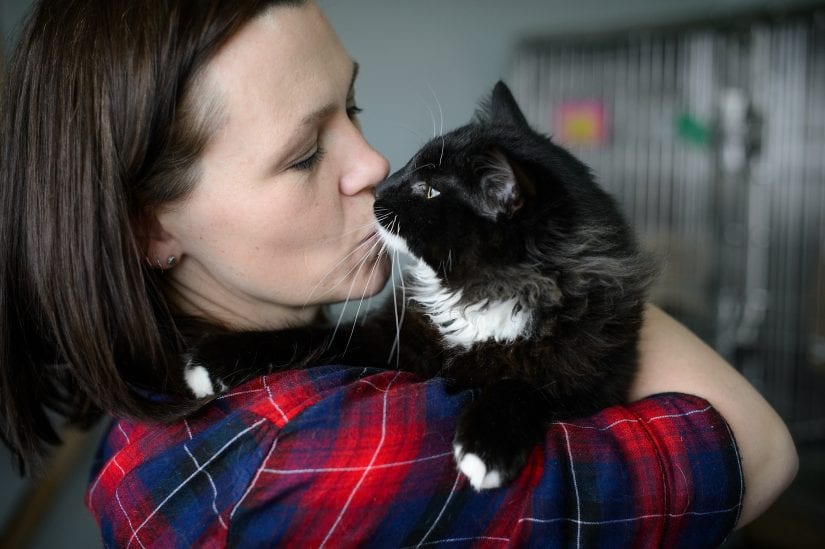
How toxoplasmosis is transmitted to humans
Most people who get toxoplasmosis get it from eating undercooked meat or unwashed produce. Because cats only shed the parasite for the first few days after becoming infected, infection from cats is rare.
- Handling and/or eating raw or undercooked food
- Handling and/or eating unwashed fruits and vegetables
- Drinking unpasteurized milk
- Eating or drinking from contaminated sources
- Being exposed to cat feces from their litter box
- Being exposed to gardens or sandboxes that may have cat feces in them
Toxoplasmosis and pregnancy
Pregnant women and people with compromised immune systems are more at risk for infection. If a pregnant woman becomes infected, her baby may have health problems.
Can pregnant women be around cats?
Yes, pregnant women can be around their cats, though there are some precautions to take:
- Do not change your cat’s litter. If you have to change the cat’s litter yourself, make sure you wear gloves and thoroughly wash your hands after
- Do not interact with any unknown cats
- Keep your cat inside
- Don’t feed any raw or undercooked meat to your cat

Still concerned about your pet and your baby?
- If you have more questions or concerns about toxoplasmosis and your baby’s health, please talk to your doctor.
- If you are concerned about toxoplasmosis and your pet’s health, please talk to your veterinarian.
Nobody plans to lose a pet. Prepare for the unexpected by following these steps to provide your pet with identification.
Provide two forms of identification
- A collar and tag: Keep a collar and tag on your pet with your home phone number and address.
- A form of permanent ID (microchip or tattoo): Pets can slip their collars at any time, but they can’t slip a permanent ID. Make an appointment with your vet to get your pet a microchip or tattoo today.
Register your pet’s permanent ID
Register your pet with the BC Pet Registry, B.C.’s first provincial pet ID database, owned and operated by the BC SPCA.
Registration guarantees that your pet can be traced by all participating veterinarians and animal care centres province-wide.
Remember: Permanent ID has little value unless it is registered. Give your pet the protection of registered pet ID today.
Learn more about the BC Pet Registry and how to plan ahead for peace of mind.
Keep your contact information up-to-date
Have you moved or changed your phone number? Don’t forget to update your pet’s ID! Contact your veterinarian with your new information so they can update their records.
Is your pet’s ID registered with the BC Pet Registry? Updating is easy! Log in any time to update your contact information.

Licensing your pet
In most municipalities, a license for your dog is required by law. Call your local city/municipality to update the records on file or to get more information on licensing.

Puppies and kittens should start their vaccines at six to eight weeks of age. Your puppy or kitten will need a series of vaccines before they are four months old. Schedules for adult animals may vary depending on lifestyle and vaccines needed.
Rescue animals may require more frequent vaccines while they are in the care of an animal centre due to a high risk of exposure to disease.
Talk to your veterinarian about when to vaccinate your animal.
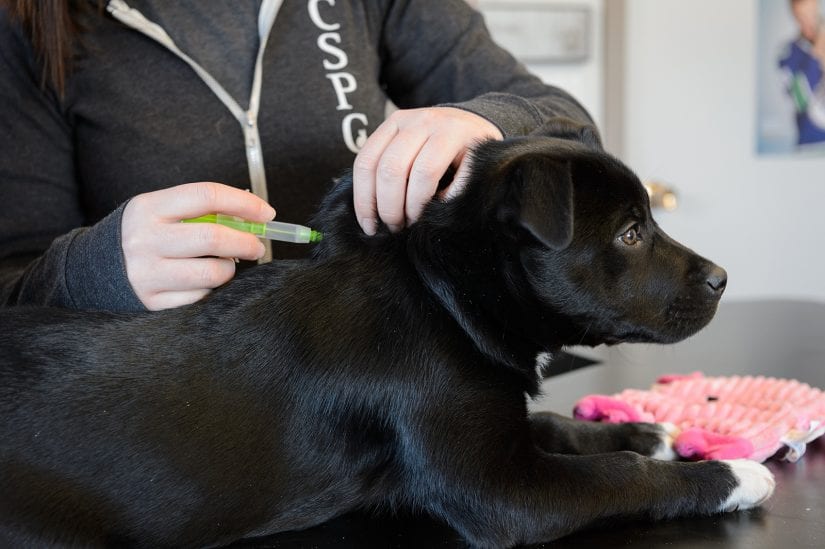
Most unintentional litters (particularly with cats) occur because guardians waited too long to have the surgery done. The usual recommendation is before six months of age for cats, and before six and a half months for dogs. Consult your veterinarian to determine the best time for your pet. Female cats and dogs do not have to have a litter before being fixed.
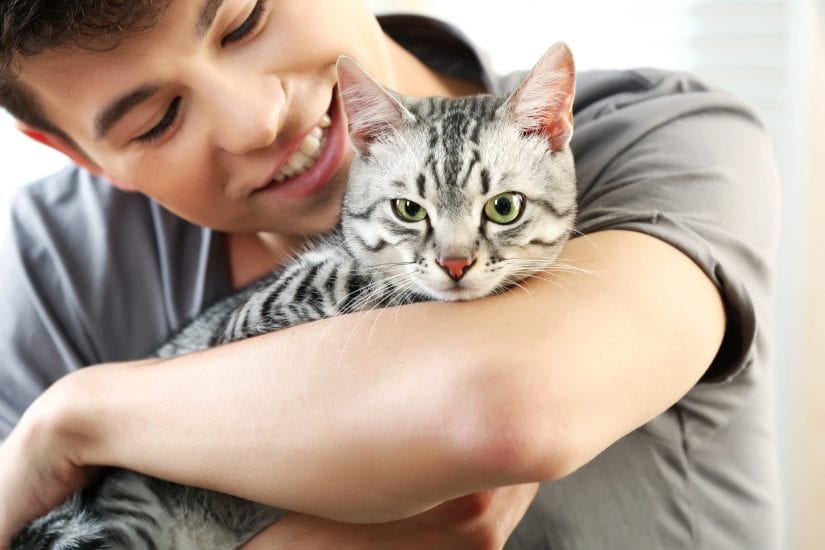
The BC SPCA supports early age spay/neuter procedures for dogs and cats. Pediatric sterilization prevents excess litters by ensuring animals are sterilized before adoption. This helps combat pet overpopulation and euthanasia of unwanted animals. All major professional, academic, and animal welfare organizations in North America support pediatric spay/neuter for shelter animals.
The BC SPCA will continue to promote other methods of combating pet overpopulation, including education and public awareness campaigns, non-surgical methods of sterilization, traditional spay/neuter initiatives and behaviour training.
The BC SPCA believes pediatric spay/neuter to be appropriate with the following qualifications:
- The procedure takes place between 8 and 16 weeks of age
- The animal is judged to be clinically normal and healthy prior to surgery
- Proper surgical protocols specific to these young animals are employed
- Post-surgery complications receive special attention
Vaccines protect your pet from getting diseases that are contagious and possibly fatal. Vaccinating your pet doesn’t just protect your pet, it also protects other pets in the community who may be too young or sick to be vaccinated. Vaccines also protect against some diseases that can be passed from pets to people.
All cats and dogs should receive vaccines. Your veterinarian can help determine which vaccines are necessary and the best schedule for vaccinating based on your pet’s lifestyle and age.
Talk to your veterinarian about vaccines for your pet.

No. Your pet will actually benefit from spaying or neutering, because he or she will lead a healthier and longer life. Pets become fat and lazy as a result of overeating and a lack of exercise, not from spaying or neutering. Furthermore, spaying a female eliminates the possibility of her developing uterine and/or ovarian cancer and greatly reduces the chance of breast cancer. Neutering a male eliminates the risk of testicular cancer.

Generally, spaying or neutering your pet will not change its personality. If there are any effects on behaviour, they tend to be positive (reducing unwanted behaviour). Spaying or neutering will not change your pet’s affection level or playfulness.
For females, there is typically no change at all. For males, there may be a reduction in some aggressive and roaming behaviours. If you have more than one pet, you will find they often get along much better if they are all spayed or neutered.
Learn more about the benefits of spaying and neutering your pet.
